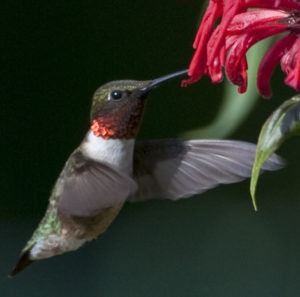Hummingbirds are much loved and welcomed visitors to gardens and backyards across the country. In order to survive, they must feed almost constantly or they would literally starve to death. It has been estimated that if hummingbirds were the size of people, then they would need 155,000 calories a day to survive. However, all animals must sleep. So at night hummingbirds go into what is called a state of torpor.
Torpor is kind of like a short-term hibernation. While in torpor, they lower their metabolism to the point where they can appear dead. Their breathing and heart rate is extremely slow and almost undetectable. They also lower their body temperature. All of this saves energy and allows the birds to sleep without starving.

Obviously, having a steady and reliable supply of nectar, usually through flowers but also sometimes from hummingbird feeders is crucial for a hummingbird to survive. However, climate change is causing many plants to bloom at different times than they did 20, 50, or 100 years ago. If hummingbirds and other animals that rely on flowers can’t adjust to the changes in bloom times, then there may come a time when those animals may not be able to survive. This is especially challenging for animals like hummingbirds that migrate long distances between their winter and summer homes.
Back in April, we talked about how people could help scientists study the effects of climate change on plants by tracking the bloom times of various plants through Project Budburst. People can also help scientists study how hummingbirds are being affected by the changing flowering times through another project called Hummingbirds at Home. Hummingbirds at Home was created by the Audubon Society and like Project Budburst, anyone can participate in the project.
Hummingbirds at Home is an ongoing citizen science project and you can start participating at any time. You don’t need much equipment to participate in the project. You’ll need a place, called a patch, where you can watch hummingbirds. The patch can be any size you choose. You’ll also need a smartphone, tablet, or computer to log your data. Before getting started, you’ll need to go to the website and create an account where you enter your data.
There are several ways in which you can participate. You can chose to watch a single nectar source and record how many hummingbirds visit the nectar source during a period of time that you set in advance. You can also make random observations any time you see a hummingbird feeding, whether it is in your patch or not. Probably the most valuable way to participate is through repeated surveys of the same patch for a pre-determined amount of time and during a pre-determined time period. You get to decide how often to repeat the survey, what the pre-determined amount of time is, and when the pre-determined time period takes place.
The website includes videos and tutorials describing the project. There are also guides for identifying hummingbird species and the flowers they might be using. In Kentucky and the rest of the eastern U.S., identifying the hummingbird species is easy because we typically only have the ruby-throated hummingbird here during the summer. Any other species of hummingbird seen here should be reported to the state ornithological society (in Kentucky that would be the Kentucky Ornithological Society) as a potential rare bird sighting.
Hummingbird numbers in many locations are increasing as the young of the year are out of the nest. Both adults and young birds are preparing for the long journey south. With so many hummingbirds out and coming to nectar sources, now is a great time to start participating in Hummingbirds at Home. The more people who participate, the more scientists can learn about these beautiful little birds.

This article was part of Shannon’s original Kentucky Pollinators and Backyard Wildlife blog which evolved into the blog for Backyard Ecology.

Backyard Ecology: Exploring Nature in Your Backyard
Nature isn’t just “out there.” It’s all around us, including right outside our doors. Hi, my name is Shannon Trimboli, and I am the host of Backyard Ecology. I live in southcentral Kentucky and am a wildlife biologist, educator, author, beekeeper, and owner of a nursery specializing in plants for pollinators and wildlife conservation. I invite you to join me as we ignite our curiosity and natural wonder, explore our yards and communities, and improve our local pollinator and wildlife habitat. Learn more or subscribe to my email list at www.backyardecology.net.

Leave a Reply